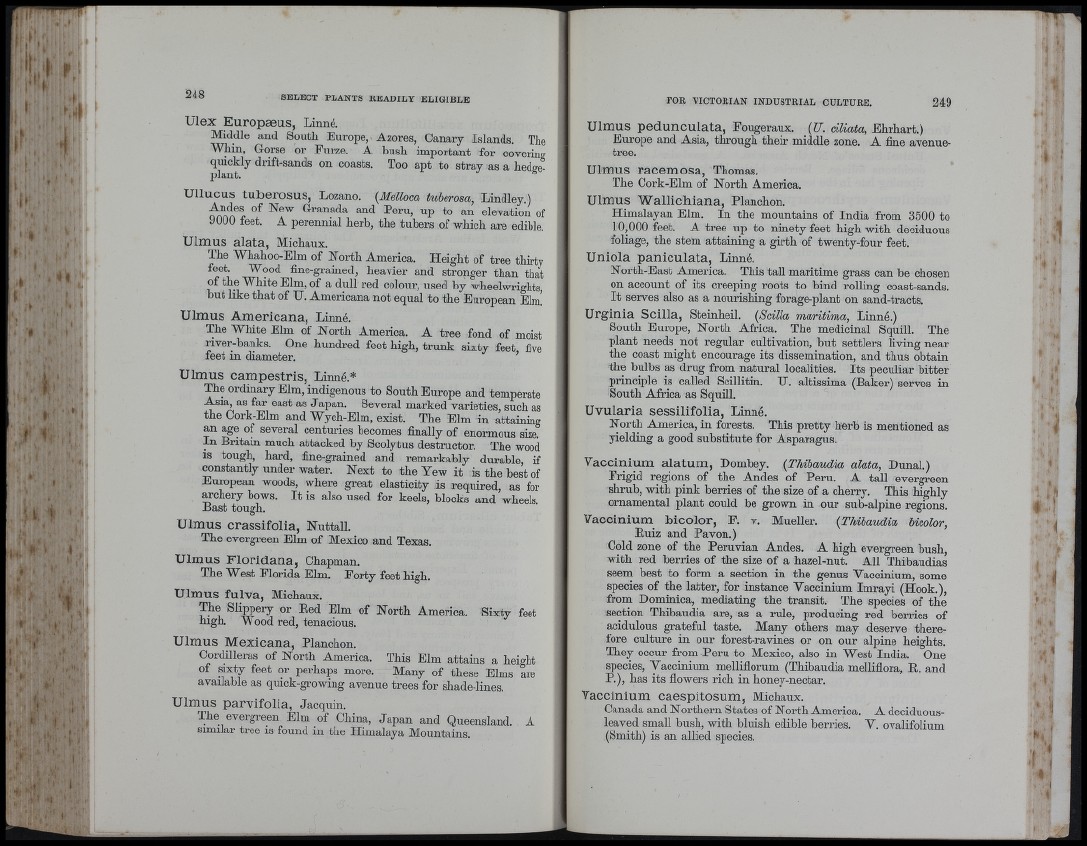
' I I
. 1
Ulex Europæus, Linné.
Middle and Soutli Europe, Azores, Canary Islands. The
Winn, Gorse or Eurze. A bush important for covering
quickly drift-sands on coasts. Too apt to stray as a hedge
Ullucus tuberosus, Lozano. {Melloca tuberosa, Lindley.)
Andes of New Granada and Peru, up to an elevation of
9000 feet. A perennial herb, the tubers of which are edible,
Ulmus alata, Michaux.
The Whahoo-Elm of North America. Height of tree thirty
feet. Wood fine-grained, heavier and stronger than that
of the White Elm, of a dull red colour, used hy wheelwrights,
but like that of U. Americana not equal to the European Elm!
Ulmus Americana, Linné.
The White Elm of North America. A tree fond of moist
river-hanks. One hundred feet high, tru n k sixty feet five
feet in diameter. ’
Ulmus campestris, Linné.*
The ordinary Elm, indigenous to South Europe and temperate
Asia, as far east as J apan. Several marked varieties, such as
the Cork-Elm and Wych-Elm, exist. The Elm in attaining
an age of several centuries becomes finally of enormous size.
In Britain mucli attacked by Scolytus destructor. The wood
is tough, hard, fine-grained and remarkably durable if
constantly under water. Next to the Yew it is the best of
European woods, where great elasticity is required, as for
archery bows. I t is also used for keels, blocks and wheels
Bast tough.
Ulmus crassifolia, Nuttall.
The evergreen Elm of Mexico and Texas.
Ulmus Floridana, Chapman.
The West Florida Elm. Forty feet high.
Ulmus fulva, Michaux.
The Slippery or Eed Elm of North America. Sixty feet
high. Wood red, tenacious.
Ulmus Mexicana, Planchón.
Cordilleras of North America. This Elm attains a height
of sixty feet or perhaps more. Many of these Elms are
available as quick-growing avenue trees for shade-lines.
Ulmus parvifolia, Jacquin.
The evergreen Elm of China, Japan and Queensland. A
similar tree is found in the Himalaya Mountains
Ulmus pedunculata, Fougeraux. {U. ciliata, Ehrhart.)
Europe and Asia, through their middle zone. A fine avenue-
tree.
Ulmus racemosa, Thomas.
The Cork-Elm of North America.
Ulmus Wallichiana, Planchón.
Himalayan Elm. In the mountains of India from 3500 to
10,000 feet. A tree up to ninety feet high with deciduous
foliage, the stem attaining a girth of twenty-four feet.
Unióla paniculata, Linné.
North-East America. This tall maritime grass can be chosen
on account of its creeping roots to bind rolling coast-sands.
I t serves also as a nourishing forage-plant on sand-tracts.
Urginia Scilla, Steinheil. (Scilla maritima, Linné.)
South Europe, North Africa. The medicinal Squill. The
plant needs not regular cultivation, but settlers living near
the coast might encourage its dissemination, and thus obtain
the bulbs as drug from natural localities. Its peculiar bitter
principle is called Scillitin. U. altissima (Baker) serves in
South Africa as Squill.
Uvularia scssilifolia, Linné.
North America, in forests. This pretty herb is mentioned as
yielding a good substitute for Asparagus.
Vaccinium alatum, Dombey. {Thihaudia alata, Dunal.)
Erigid regions of the Andes of Peru. A tall evergreen
shrub, with pink berries of the size of a cherry. This highly
ornamental plant could be grown in our snh-alpine regions.
Vaccinium bicolor, F. v. Mueller. {Thihaudia bicolor,
Buiz and Pavon.)
Cold zone of the Peruvian Andes. A high evergreen bush,
with red berries of the size of a hazel-nut. All Thibaudias
seem best to form a section in the genus Vaccinium, some
species of the latter, for instance Vaccinium Imrayi (Hook.),
from Dominica, mediating the transit. The species of the
section Thihaudia are, as a rule, producing red berries of
acidulous grateful taste. Many others may deserve therefore
culture in our forest-ravines or on our alpine heights.
They occur from Peru to Mexico, also in West India. One
species, Vaccinium melliflorum (Thibaudia melliflora, E . and
P.), has its flowers rich in honey-nectar.
Vaccinium caespitosum, Michaux.
Canada and Northern States of North America. A deciduousleaved
small bush, with bluish edible berries. Y. ovalifolium
(Smith) is an allied species.
iti